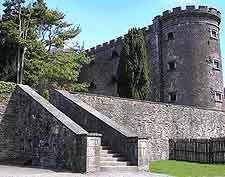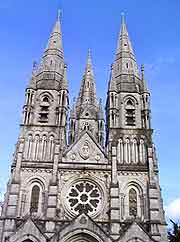Cork History Facts and Timeline
(Cork, County Cork, Ireland)

Cork has a long and turbulent history. Its name is said to originate from 'Corcach Mór Mumhan, which means 'great marsh of Munster'.
Whilst there's some debate about when a settlement first grew up in Cork, it's widely acknowledged that a Celtic monastery was established here during the 6th or 7th century. In all likelihood, it was located on land around St. Fin Barre's Cathedral. The monastery suffered many Viking attacks during its early days, however, eventually the two communities began to live more harmoniously.
In the Middle Ages
By the 12th century, the town's inhabitants had become known as Ostmen. The town was an important and powerful trading centre under the lordship of the MacCarthys, although their control was rather brief. In 1177, the town was overrun by Norman forces headed by Robert FitzStephen and Milo de Cogan. Around 1185, Cork was granted a charter that endowed it with the powers of local government and conferred city status.
During the Middle Ages history, a wall was built and later extended, transforming Cork into one of the most notable walled cities to be found in Ireland. Cork traded extensively with Britain and
France. Indeed, in the 13th and 14th centuries, the city was reputed to be the main port in south-western Ireland, trading in everything from wool to beef. Such prosperity was to be short-lived. The city was beset by problems that included outbreaks of disease and attacks from Gaelic people living outside its walls. A fire in 1354 must have seemed like the last straw.
History from the 15th to the 17th Century
By the 15th century, Cork was run by a few wealthy merchants, a patriarchy that did little to revive its fortunes. Still in decline, its northern and southern quarters were largely neglected, leading to a city that was bound within its own defensive walls. By the end of the 1600s, Catholicism had regained a firm hold over the city. However, those loyal to the Anglican church also remained, leading to a growing religious divide that was to continue throughout the 17th century. In 1644, matters came to a head when the Catholic Irish population was expelled.
For the first time in centuries, the great Catholic merchant families were no longer in charge of civic affairs. Cork's fortunes started to rise once more, along with its population. New houses were built, both within and without the city walls. Slowly, it also regained its position as a centre for trade. In the mid-17th century, Cork was to become a place of conflict once more. During the English Civil War, Cromwell ousted the old Irish merchant families who had returned to rule under the banner of the Royalists. Then, in 1690, Cork came under renewed attack. William of Orange and his wife Mary sought to reestablish Protestant control. Under severe bombardment from William's forces, the city eventually fell.

18th-Century History to the Present
By the 18th century, Cork was back on the road to economic prosperity thanks to a brisk trade in butter and beef. Indeed, in time, the Cork Butter Market was to become world famous. Other industries back then included sail making, and both woollen and cotton manufacturing. Some of the marshland surrounding the city was reclaimed and bridges were built to link the centre with the suburbs.
The 1800s saw the arrival of many public utilities and buildings, including, in 1849, the opening of Queen's College. During the 1920s, there were serious attempts to deal with the city's slums. The 1970s saw local industries suffer, causing many young inhabitants to leave in search of work. In the 1990s, Cork began to experience a period of economic growth and, in recent years, it has grown into a vibrant modern city.
 Cork has a long and turbulent history. Its name is said to originate from 'Corcach Mór Mumhan, which means 'great marsh of Munster'.
Cork has a long and turbulent history. Its name is said to originate from 'Corcach Mór Mumhan, which means 'great marsh of Munster'.